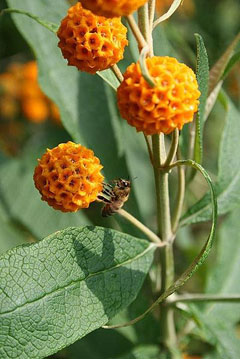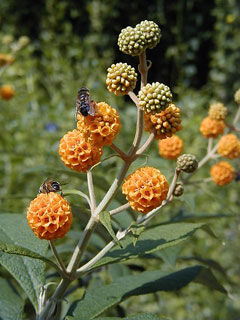 |
|
http://commons.wikimedia.org/wiki/User:Penarc |
 |
| http://commons.wikimedia.org/wiki/User:Cillas |
Translate this page:
Summary
Physical Characteristics

 Buddleia globosa is an evergreen Shrub growing to 5 m (16ft) by 5 m (16ft).
Buddleia globosa is an evergreen Shrub growing to 5 m (16ft) by 5 m (16ft).
See above for USDA hardiness. It is hardy to UK zone 7. It is in leaf all year, in flower from June to July. The species is monoecious (individual flowers are either male or female, but both sexes can be found on the same plant) and is pollinated by Bees, Lepidoptera (Moths & Butterflies).
Suitable for: light (sandy), medium (loamy) and heavy (clay) soils and prefers well-drained soil. Suitable pH: mildly acid, neutral and basic (mildly alkaline) soils. It cannot grow in the shade. It prefers moist soil. The plant can tolerate maritime exposure.
UK Hardiness Map
US Hardiness Map
Synonyms
Buddleja globosa
Plant Habitats
Woodland Garden Sunny Edge; Dappled Shade;
Edible Uses
References More on Edible Uses
Medicinal Uses
Plants For A Future can not take any responsibility for any adverse effects from the use of plants. Always seek advice from a professional before using a plant medicinally.
Miscellany
One report says that it is cultivated as a medicinal plant in S. America but gives no more details[184].
References More on Medicinal Uses
The Bookshop: Edible Plant Books
Our Latest books on Perennial Plants For Food Forests and Permaculture Gardens in paperback or digital formats.

Edible Tropical Plants
Food Forest Plants for Hotter Conditions: 250+ Plants For Tropical Food Forests & Permaculture Gardens.
More

Edible Temperate Plants
Plants for Your Food Forest: 500 Plants for Temperate Food Forests & Permaculture Gardens.
More

More Books
PFAF have eight books available in paperback and digital formats. Browse the shop for more information.
Shop Now
Other Uses
References More on Other Uses
Cultivation details
Requires a sunny position[11, 182]. Prefers a rich loamy well-drained soil[11, 200]. Very tolerant of alkaline soils[200]. Grows well by the sea, tolerating maritime exposure[184, 200]. Plants are hardy to about -15°c if they are sheltered from cold winds[184, 200]. They resprout freely from the base if cut back by cold weather[200] and are deciduous in cold winters[188]. Plants flower on the previous year's growth[200]. The flowers scent the air for a considerable distance with their sweet honey-like fragrance[245].
References Carbon Farming Information and Carbon Sequestration Information
Temperature Converter
Type a value in the Celsius field to convert the value to Fahrenheit:
Fahrenheit:
The PFAF Bookshop
Plants For A Future have a number of books available in paperback and digital form. Book titles include Edible Plants, Edible Perennials, Edible Trees,Edible Shrubs, Woodland Gardening, and Temperate Food Forest Plants. Our new book is Food Forest Plants For Hotter Conditions (Tropical and Sub-Tropical).
Shop Now
Plant Propagation
Seed - cold stratify for 4 weeks at 4°c[138] and surface sow the seed in February/March in a greenhouse[78, 113]. Germination usually takes place within 3 - 4 weeks at 21°c[138]. When large enough to handle, prick the seedlings out into individual pots and grow them on in the greenhouse for at least their first winter, planting them out into their permanent positions in late spring or early summer, after the last expected frosts. Seedlings are inclined to damp off and so should be watered with care and kept well-ventilated[78]. Cuttings of half-ripe wood, July/August in a frame[11, 113]. Use short side-shoots[78]. Very high percentage[113]. Cuttings of mature wood of the current season's growth, 15 - 20cm long, October/November in a frame[200].
Other Names
If available other names are mentioned here
Native Plant Search
Search over 900 plants ideal for food forests and permaculture gardens. Filter to search native plants to your area. The plants selected are the plants in our book 'Plants For Your Food Forest: 500 Plants for Temperate Food Forests and Permaculture Gardens, as well as plants chosen for our forthcoming related books for Tropical/Hot Wet Climates and Mediterranean/Hot Dry Climates. Native Plant Search
Found In
Countries where the plant has been found are listed here if the information is available
Weed Potential
Right plant wrong place. We are currently updating this section.
Please note that a plant may be invasive in one area but may not in your area so it’s worth checking.
Conservation Status
IUCN Red List of Threatened Plants Status :

Growth: S = slow M = medium F = fast. Soil: L = light (sandy) M = medium H = heavy (clay). pH: A = acid N = neutral B = basic (alkaline). Shade: F = full shade S = semi-shade N = no shade. Moisture: D = dry M = Moist We = wet Wa = water.

Expert comment
Author
Hope.
Botanical References
200
Links / References
For a list of references used on this page please go here
Readers comment